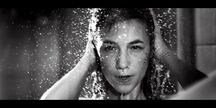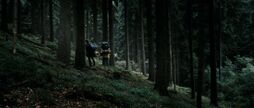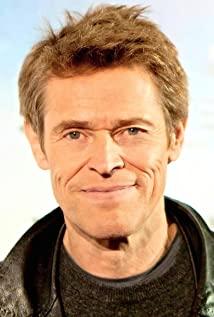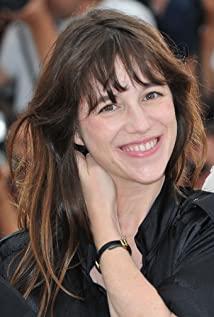Records of some internal laws of the film
Prologue
The man's face appears on the left side of the screen, and water droplets fall on the right side of the screen. The camera cuts to the woman taking a bath and the ventilator fan is turning; at the same time and space, snow falls outside the window, and the window and curtains are blown open by the wind. At this time, three statues are seen on the window. ;The camera quickly cuts to the men and women having sex in the bathroom, the toothbrush cup is knocked over, the scale is kicked away, the washing machine is rolled, the baby toys are turned, the baby throws the toys, the 3 statues reappear, the water droplets float in the air, and the baby's The left and right feet of the shoes were wrongly placed, and the feet kicked over the carafe. The water kept flowing out. The baby opened the door and the glass bottle rolled off the table. The focus of the picture is zoomed in from the man and woman in the distant view to the baby. It turns its head to look at the audience, and then looks at the window. At this time, the baby is invited by the audience equal to us to enter the time and space of the movie;
The same time and space: repeated rotating images (ventilator/washing machine/toy)
Falling image (toothbrush cup/glass bottle/toy/figurine/baby/drop/snow)
The same picture composition:
man in love = baby jumping from window
woman with open mouth = falling baby
Cut to washing machine rolling, cut back to woman, cut to washing machine
At the same time when the male and female protagonists are united (climax) = death
Chapter 1 Grief
The first time a woman cried, she blamed herself ("I could've stopped him." and a recap of the baby's behavior), and here you can vaguely feel that this self-blame does not point to "I could have saved him", but "I could have saved him." Evil caused by one hand";
The woman resists the man's treatment, frequently skips the editing, the camera cuts to the vase, zooms in and out to the rotten roots and dirty water in the vase, the surface maintains a calm doctor-patient/husband and wife relationship, and under the calm, women treat men Distrust of the therapeutic effect (husband's fatherhood), a selective, compulsive, indulgence of inner evil begins to emerge;
The woman cried for the third time, looking at the man as a prospect, blaming the man for his dereliction of duty as a father (“I never interested you until now I am your patient.”) for the cause of the baby accident, but in fact a series of questions about the man as a husband (male identity). absent;
Here the woman takes the initiative to have sex, is rejected by the man, and the woman falls ill in the bathroom (the treatment is ineffective);
The woman took the initiative to have sex again, and the man said: "This won't do", and continued to forcibly treat;
Men's rational treatment is confronted by women's fit, and women are confronted by men's rationality again. Here, the doctor-patient relationship and the fit relationship are confronted in the same time and space. , invisible (hallucination); this progressive confrontation also heralds the final direction of the story;
At the end of this chapter, the man sees the dystocia deer. The deer represents grief in the film. For men, "grief is not dangerous, is physical". The torture in the last scene: Is the deer a reality or an illusion? Is sadness just a physiological response that can be observed and manipulated?
Chapter 2 Pain
The fourth time the woman cried, the man carried the woman across the grass to complete the task, the bird fell off the tree and was eaten by the big bird. cure;
The woman heard the cry and walked into the hut to find the baby. The cry in the background couldn't match the shape of the baby's mouth. According to the judgment of the man, the cry = hallucination, nature = forest = human nature, the cry of the whole forest in the background indicates that Women's inner humanity needs to be vented, unable to be suppressed, and completely awakened. The man is the guide, guiding the woman to see the inner logic and nature of the self, being awakened and confirmed; the man looks at the autopsy report, then looks at the camera, zooms out, and the acorn rain falls on the right side of the man (corresponding to the opening water droplets on the right side of the man). falling sideways), the time and space in the film are split. The failure of the man's treatment is witnessed and confirmed, and his loss/sensibility is divided;
The woman leads the man into the mountain, takes the man out of the cave, and asks "you can't just be happy for me, can you?" impulse;
Chapter 3 Despair
The woman took the initiative to have sex again. After being rejected, she rushed into the forest and masturbated at the entrance of the hole. The man chased out, and there were countless hands interspersed in the trunk;
The Pyramid of Fear, each time it reveals a part of a woman's truth, it stirs up her hostility;
Women nailed men's legs and put children in opposite shoes, subconsciously not wanting them to leave, and controlled by themselves;
Chapter 4 The Three Beggars
Flashback opening sex scene - baby falls - clitoris clipping - baby falls - rains - deer appears - fox walks - crow falls - man strangles woman, from birth (sex), from death (fit = death), from death Finish;
On the train in the title sequence, the woman goes to the forest in her head, the man walks out of the forest, and the man and woman merge into one and reunite in an equal way;
Epilogue
Black and white picture, fox, deer, crow reappear in the grass, is it a rebirth or a man's hallucination? Has his reason been abandoned? Countless faceless women emerge from the surface to go high, and the whole movie is full of falling/falling imagery, only the last moment rises.
When I write about reason/madness, reality/illusion, do I presume that madness and illusion are irrational, non-objective, anti-logical, inherently evil? Even when only asking questions to the work itself, it is inevitable that there will be subconscious biases. The author must think more and deeper than us. During the repeated viewing process, you will find that the questions raised have already been answered through the mouths of the actors, such as women. From the first healing saying: "but I don't know what I'm afraid of… can't I just be afraid without a definite object?" to the later awakening of inner evil "'now I could hear what I couldn' t hear before, the cry of all the things that are to die", "The crying woman is a scheming woman";
Constant interpretation is a process of constantly asking questions to the work and to oneself. When it is said that it is perverted, twisted, and forced, is it actually resisting its own "darkness", emphasizing its own "purity, morality, and nobleness" and taking pride in it? When expressing opinions, do you really understand, or is it just a projection of prejudice in your head?
The author explores his own boundaries when reflecting and criticizing, and has been exploring the source of his soul. We are just trying to see the works in front of us. Thanks to the author for giving us the opportunity to constantly test our way of viewing with good works.
View more about Antichrist reviews










